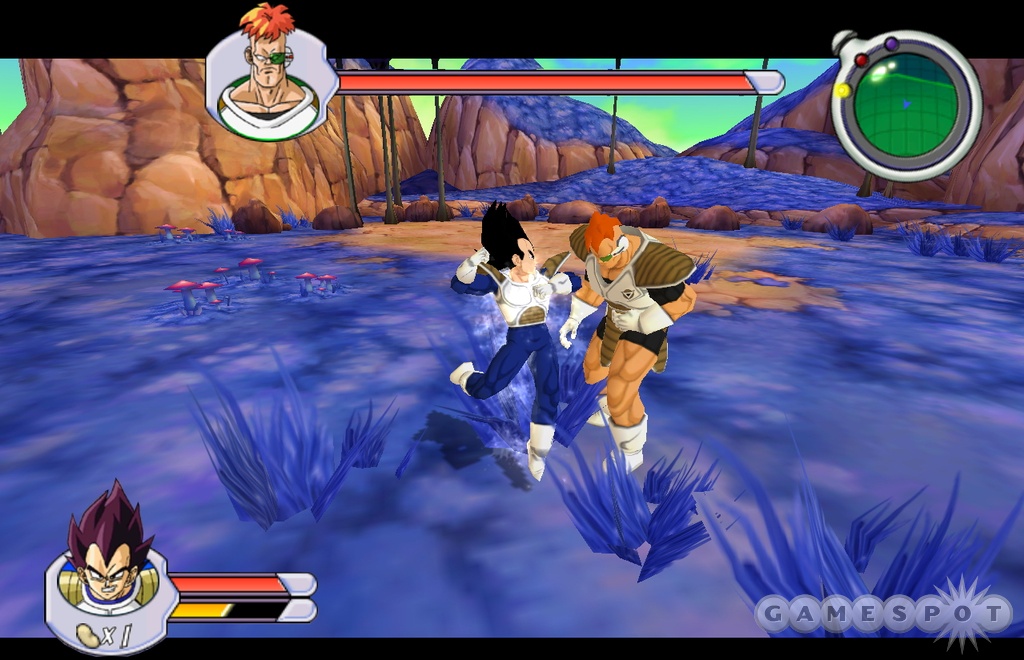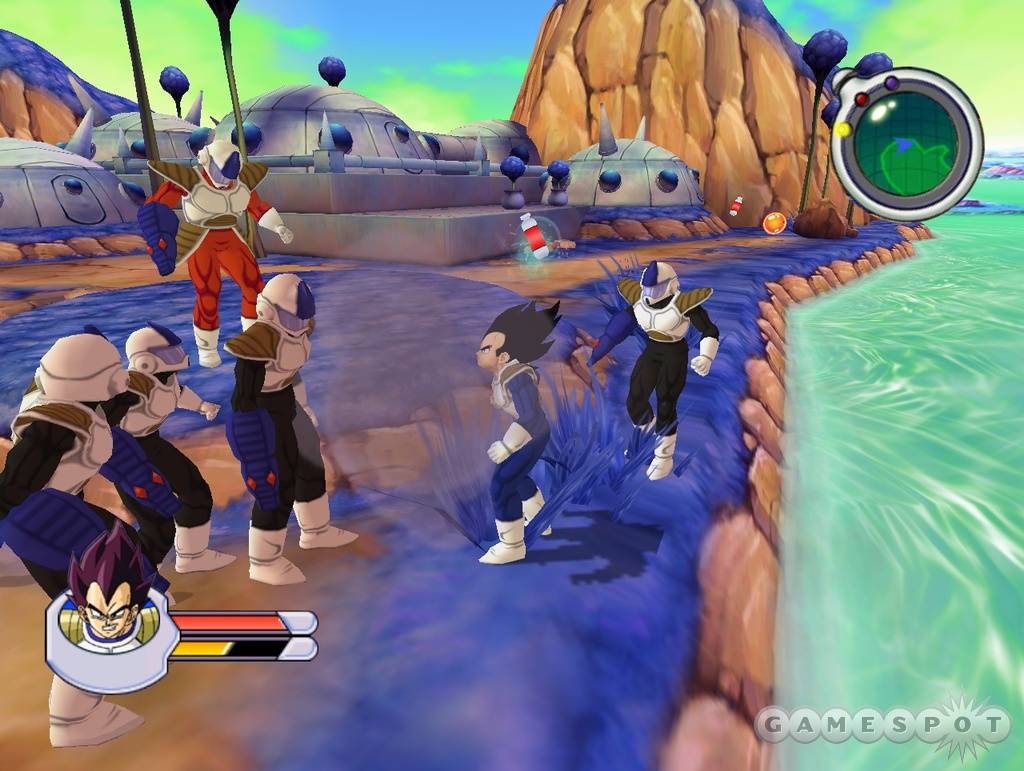Dragon Ball Z: Sagas Preview
We get an exclusive look at Atari's upcoming DBZ action game.
We got our first look at Dragon Ball Z: Sagas two months ago, when Atari unveiled the latest branch in its burgeoning DBZ games franchise. The game takes the series in a new and natural direction that presents a smarter use of the rich story that is the backbone of the popular long-running anime. We recently had a chance to take exclusive looks at work-in-progress incarnations of the three console versions of the game, developed by veteran studio Avalanche Software, to see how they've shaped up. While the versions weren't as polished as the recently announced final gold copies, they did give us a good feel for where the latest DBZ iteration is headed.
As with Atari's recent games based on Dragon Ball Z, Dragon Ball Z: Sagas draws liberally on the anime's rich lore. For those unfamiliar with the long-running 'toon, the Dragon Ball series revolves around the defense of Earth by powerful superbeings. The anime series has gone through a hefty number of story arcs that have both spanned decades and featured an ever-growing cast of eccentric characters. Dragon Ball Z: Sagas' narrative focuses on two of the very first story arcs in the series (arguably the most beloved by that chunk of fans whose first exposure to the series was with these arcs): the Saiyan and Cell Game Sagas. The two adventures comprise what is essentially the kick off to the massive DBZ storyline that continues to this day. However, unlike the popular Budokai games, which have basically been one-on-one 3D fighters with heavy emphases on story, Dragon Ball Z: Sagas is a proper action game with some "lite" role-playing game elements that give it a good deal more depth than the fighters we've seen previously. You'll still find a good helping of those elements that have been part of the DBZ renaissance in gaming, such as over-the-top combat and anime cutscenes with authentic voices, but this time out, you'll find yourself venturing through a 3D world.
You'll find one basic game mode and two supplemental modes to try out in Dragon Ball Z: Sagas. The saga mode is the one- or two-player story mode that will send you on an adventure through the two story arcs we've mentioned. The tutorial mode is a brief, interactive primer on the basics of the game that will familiarize you with the control mechanics. The pendulum mode is an unlockable mode that will let you face off against all manner of foes. Speaking of unlockable content, Dragon Ball Z: Sagas also features an extras mode that will contain a slew of content you'll open up as you play through the main game.
The sagas mode is a linear, objective-based run through 19 levels that will span the two story arcs we mentioned. You'll play as one of five characters from the series--Goku, Gohan, Piccolo, Vegeta, and Trunks--as you go through key points in the stories. Two-player support is included, so you can choose to adventure with a friend if you'd like. Each level will be introduced by an animated segment taken straight from the 'toon or created specifically for the game, which will set up the action. The story-driven focus will determine which of the characters you'll play as on a given level. So, for example, you'll start out as Goku. But once he gets sent to Otherworld (a cloudy afterlife that's big on dragons), you'll find yourself playing as his son, Gohan. Your objectives in each level will vary depending on the particular portion of the story you're going through. So, for example, when you start playing as Goku, your goals are to collect some needed items, upgrade Goku's abilities, reach his kidnapped son, and face off against Raditz. When you play as Gohan, your "to-do list" will include similar chores, but it will add in the necessary task of collecting the mystical dragon balls to revive your recently deceased papa. At the end of each level, you'll be treated to a stat screen that will tally what went on, such as your attacks and items collected.

The game mechanics are accessible and should be a piece of cake to pick up for just about anyone. The core controls are a basic but functional assortment of moves that will grow over the course of play. You'll move your character with the analog stick. You'll have access to a punch, kick, jump, and ki blast. The left trigger will let you lock on to foes and focus your attacks on them, as well as keep your movement centered around them while they're locked, allowing you to quickly dodge their attacks or dash at them. The right trigger will let you fill up your ki meter, the energy source for the blasts you can fire, when you hold it and the jump button down. You can also perform moves seen in the anime, such as flying. This can be handled by pressing the jump button twice and unleashing mighty combo and ki attacks, although the latter will have to be unlocked when you upgrade your character by using the coins you'll collect over the course of your adventure.
The collectibles in the game are a basic assortment of four items. The two most important items are Z coins and senzu beans. Z coins are what you'll use to upgrade your character's abilities, while senzu beans will act as extra lives, allowing you to both regain full health after a defeat and continue your game from that point. The other two collectibles, red and yellow capsules, offer a longer-term benefit...if you can find enough of them. You'll find both types of capsules strewn throughout the levels you'll explore, and you can collect them, of course. Red capsules will restore a measure of health, while yellow ones will refill your ki a bit. However, if you manage to collect 10 of either, you'll gain a permanent increase in health or ki, which comes in handy as the action heats up.
Kame Hame Ha!
The upgrade system is a straightforward bit of self-improvement you can perform at upgrade points you'll find at set points. You'll be able to spend your Z coins on upgrades to one of three areas for your fighter. Ki attack upgrades will buff up your ki-powered abilities, such as quick recovery, teleporting, and special moves that let you charge and unleash significantly more-powerful energy blasts. Melee attack upgrades will broaden the basic types of attacks you can perform, as well as let you perform uppercuts, roundhouses, combo breakers, unblockable finishes, and throws.

Finally, combo attack upgrades will let you perform much more powerful combo attacks that are triggered by button combinations. So, for example, when you start the game, you'll be able to unleash simple punch or kick combos that will require you to hit either attack five times in a row. Once you upgrade, you'll be able to trigger mightier attacks that will require you to hit punch twice and kick three times, or any other number of variations. And, yes, the upgrades will include the ability to morph into super Saiyan form, which is a souped-up, big-haired version of your character that's tailor-made for kicking butt. You'll be needing all the above upgrades when you face off against a rogues gallery of foes. The enemies you'll face will range from grunts, such as saibamen, assorted robots, and familiar faces from the series, to new enemies created specifically for the game that have been inspired by the show. However, the big-ticket battles will find you facing off against well-known villains from the series who'll be cast as bosses or minibosses.
The graphics are sharp-looking and offer yet another interpretation of the anime in-game. Whereas the Budokai games have ranged from rendering Goku and company in varying degrees of cel-shading-inspired incarnations, Sagas takes a more minimalist approach that's heavier on subtle shading and clean detail. You'll see some cel-shaded touches, such as smoke, explosions, and your destructive effect on the interactive backgrounds, but the game has its own unique look that works. The character models look good, although they're a little smaller than we're used to due to the third-person camera's position, which is necessary to frame the epic battles. We're big fans of the subtle touches, such as the clouds of dust that spiral around your character when charging ki. The environments feature a modest amount of detail and interactivity that's passable but left us wanting more. After all, once you've knocked a foe a few miles back through a mountain, you're obviously going to want to do much more.
The frame rate is shaping up to be smooth, although we've noticed some inconsistencies in our work-in-progress versions that will hopefully be addressed in the final game. Animation is good, although it's a bit jerky at times when we perform combos. However, it's nothing that ruins the experience. As far as how the offering shapes up on each platform, Avalanche's experience in creating multiplatform games, such as last year's Tak 2: The Staff of Dreams, yields solid visuals across the board. There are some subtle differences in each version, which is to be expected. The GameCube's color is a touch more vibrant, and the Xbox version has crisper visuals and a smoother frame rate. But overall, the game runs respectably well on all three consoles. The PlayStation 2 enjoys a slight benefit thanks to its status as the lead platform, which ensures the only differences between it and the other two versions are very subtle.

The audio aims to complement the authentic look of the visuals with equally faithful sound. You'll hear sound effects and voice that's either taken from the classic anime or is new dialogue recorded with the US voice actors. The music will also feature a mix of familiar themes from the anime, or it will present original tracks that fit in with the fist-pumping '80s Japanese rock that is a Dragon Ball hallmark.
Based on what we've played, Dragon Ball Z: Sagas is a modest but promising step in a new direction for the franchise. Much like the original Dragon Ball Z: Budokai, Dragon Ball Z: Sagas is a tentative first move toward doing right by the license. There's definitely a lot of potential for growth here that we'd like to see expanded, if Atari and Avalanche continue on this path. Taken on its own merit, Dragon Ball Z: Sagas is shaping up to be a solid enough action game with some decent trimmings. While the "RPG-lite elements" may be too simplistic for RPG vets, there's still a fair amount to do and upgrade on your adventure. The savvy use of key dramatis personae and story arcs is tailor-made to please fans while not alienating anyone who hasn't seen every episode of the anime. If Atari can iron out the minor performance issues we caught during our playtime, the game should be worth a look for fans of the series and anyone looking for a third-person action game with a modest amount of depth. Dragon Ball Z: Sagas is currently slated to ship later this month for the GameCube, PlayStation 2, and Xbox.
Got a news tip or want to contact us directly? Email news@gamespot.com
Join the conversation